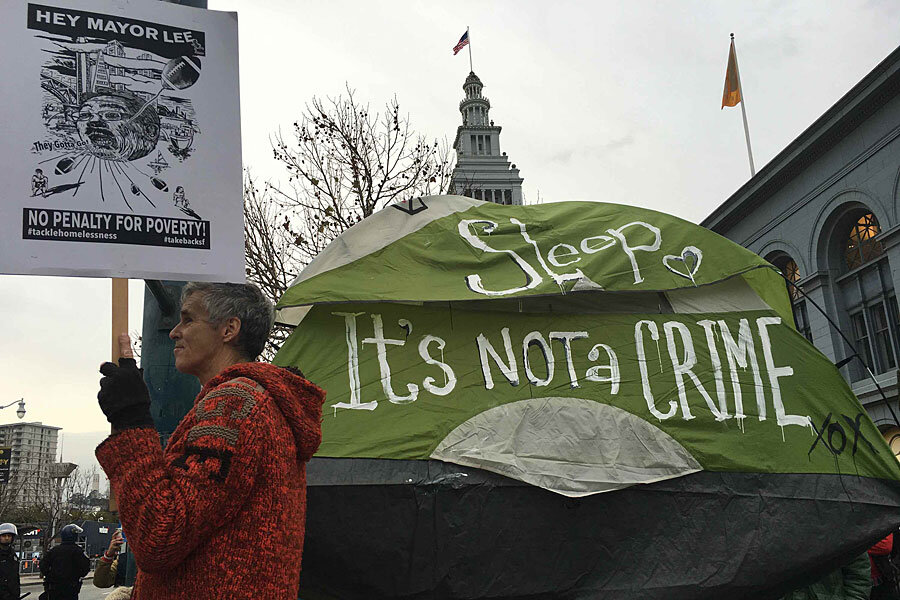Why San Francisco is moving the homeless for Super Bowl 50
Loading...
San Francisco saw demonstrations Wednesday against a citywide order to clean up the streets in advance of Super Bowl 50. Approximately 200 people came together to protest the city’s handling of the issue.
Mayor Ed Lee announced in August that the homeless would have to leave the streets in advance of the National Football League's championship game.
Although the Super Bowl is being held nearly an hour away at Levi’s Stadium in Santa Clara, San Francisco expects crowds of tourists to flood the city for fan events, concerts, and shopping in the days surrounding the event.
“We are always going to be supportive,” said Mayor Lee in August, “But you are going to have to leave the street. Not just because it is illegal, but because it is dangerous.”
The Super Bowl festivities are concentrated in an area of the city called the Embarcadero, a space of several blocks that is normally inhabited by a number of homeless people.
In his August remarks, Lee identified drug addiction and mental illness as some of the major factors that brought his city’s homeless population to the streets.
According to officials, the city began its efforts early in an attempt to address the heart of the issue rather than temporarily moving people as the Super Bowl approached. Last January, the city opened a new shelter called the Navigation Center. The new center aims to provide not only shelter, but also services such as addiction rehabilitation and housing help.
Twenty four homeless people from the Embarcadero district were moved to the Navigation Center ahead of the Super Bowl. The shelter gave priority to homeless people from areas that would be highly visible to Super Bowl fans.
San Francisco’s Coalition on Homelessness says that “street cleaning” efforts are taking place in other parts of the city that are not part of the Super Bowl festivities.
City officials claim that they are merely trying to keep homeless people out of the rain, which is especially strong this year due to El Niño. Yet, despite assertions by city administrators that they are not trying to hide San Francisco’s homeless population, police have been seen clearing homeless people away from underpasses along the Super Bowl route.
According Maria Foscarinis, the executive director of the National Law Center on Homelessness and Poverty, cities use existing laws against loitering or sitting down in public to criminalize homelessness. It is illegal for police to seize personal property such as tents, but she says they often do it anyway.
“The police told us that after the Super Bowl, y’all can come back,” one homeless man who identified himself simply as Aaron told The Wall Street Journal. Aaron and his wife Shawna recently lost their tent when ordered to relocate by police.
Ms. Foscarinis says San Francisco’s high housing prices are part of the city’s larger problem. “Unless these underlying causes are addressed,” she told The Christian Science Monitor, “this will continue to happen.”
Reuters reported that the homeless population and its advocates gathered on Wednesday to protest the city’s efforts. Protesters held their ground in a tent city erected in the Embarcadero district and advocated for their right to sleep on the streets.
Some have expressed frustration with the city’s recent attention to its 7,000-strong homeless population. One young woman, Nikki Millett, told Reuters that, "What I am against is that homelessness has been a huge problem in this city for a long time and Mayor Lee hasn't done anything about it until [the Super Bowl]."
Critics of the San Francisco’s Super Bowl preparations cite the city’s $4.8-million spending on the event’s festivities. Despite the city’s recent construction of the Navigation Center and another shelter called the Pier 80 shelter, some say that with two years to prepare, San Francisco should have invested more in advance efforts to solve its homelessness problem.
Street cleaning efforts like San Francisco’s are common in cities that are hosting big events such as sporting events or political conventions.
Many Olympic host cities, including Atlanta, London, and Vancouver, have responded by shifting homeless people off of the streets. In Atlanta and Sydney, officials forcibly removed homeless people.
In London, where homelessness and “rough sleeping” rose in the year prior to the Olympics, officials worked to address the issue long term. Despite efforts, homelessness is still on the rise in London.
Homelessness has gained attention as an issue in recent months. In January, Seattle Mayor Ed Murray was in the midst of a speech about his own city’s homeless problem when five people were shot in a homeless tent city called “the Jungle.” New York Mayor Bill de Blasio also announced a plan to forcibly move homeless people off the streets in early January.
Meanwhile, Foscarinis says the National Law Center on Homelessness and Poverty has been working with the city. She says that although San Francisco has built additional shelter space, it simply isn’t enough to shelter the city’s homeless population.







